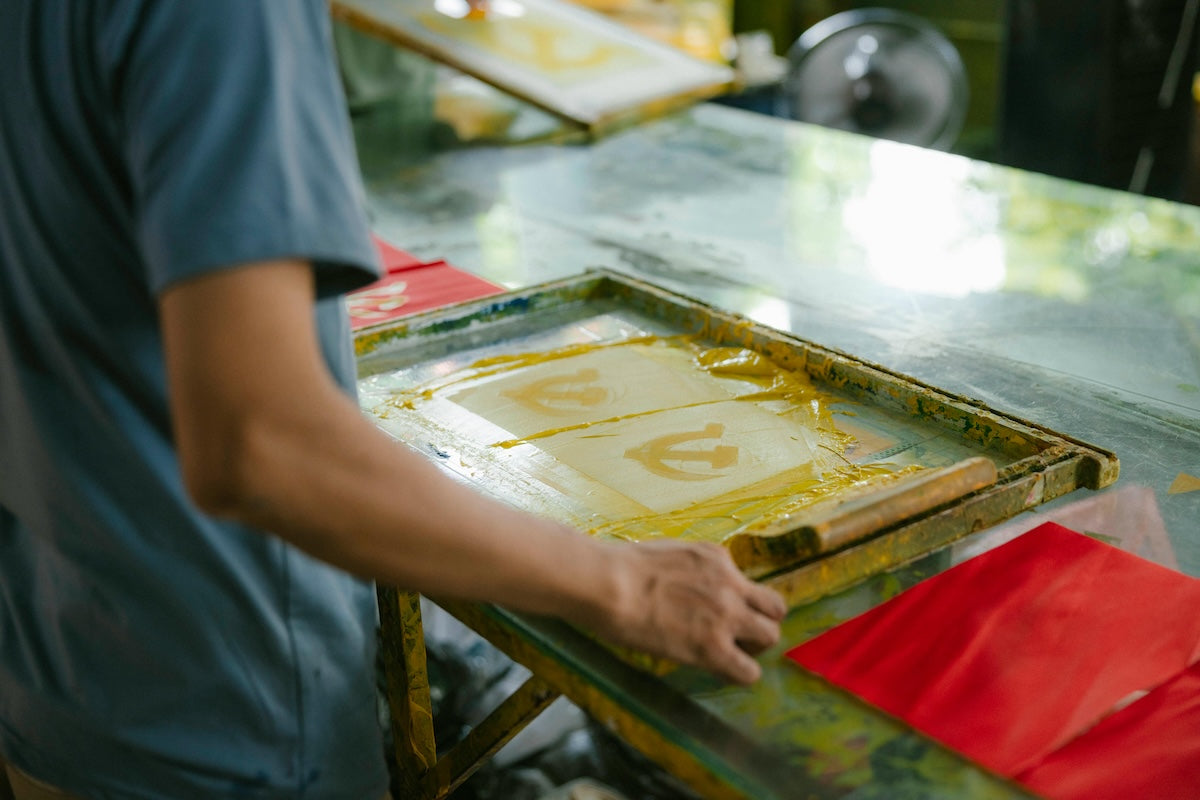What Is Screen Printing and Is It Eco-Friendly?


You’ve probably worn screen printing more times than you can count, from that perfectly broken-in concert tee to your favorite canvas tote. But have you ever wondered what screen printing actually is or whether it fits into the world of slow, sustainable fashion?
Let’s pull back the curtain on how this age-old technique works, where it stands on sustainability, and what to look for if you want your printed pieces to match your eco-values.
In simple terms, screen printing is a way to transfer ink onto fabric using a fine mesh screen. Each color in a design gets its own screen, and the ink is gently pressed through it to build up the final artwork. It’s loved by makers and brands alike because it creates vibrant, long-lasting designs that feel timeless, not trendy.
Once upon a time, these screens were made from silk (hence the name “silk screening”), but most are now made from polyester. The technique has barely changed over decades, and that’s part of its charm. It’s durable, handcrafted, and still used by both big brands and tiny local studios.
Screen printing stands out because it produces those bold, saturated colors you just can’t get with most digital prints. It also works beautifully on all kinds of fabrics, from cotton tees to linen dresses and even recycled blends. And because it’s efficient for larger batches, many small sustainable brands rely on it to keep costs manageable.
But here’s the thing: not all screen printing is created equal. Some methods are gentle on the planet, and others... not so much.
Traditional screen printing often uses plastisol inks, which are made with PVC (yep, plastic). They produce great color, but they can also release toxins if they’re not disposed of responsibly. On top of that, older studios sometimes rely on strong solvents and chemical emulsions to clean and prep screens, wasting water and adding unnecessary pollution.
It’s not all bad news, though. Just like the rest of the fashion industry, screen printing is evolving, and many modern printmakers are embracing cleaner, safer ways to create.
Today’s slow-fashion print studios are doing things differently:
Water-based inks are replacing plastisol. They soak into the fabric instead of sitting on top, giving prints a soft, breathable finish with no plastic residue.
Natural and plant-based dyes including soy, algae, and even mineral pigments, are showing up in eco collections.
Non-toxic screen cleaners and reusable materials are reducing chemical waste.
Closed-loop washing systems are helping studios reuse and filter water instead of sending pigment runoff down the drain.
When you see “eco screen printed” or “water-based inks” listed in a product description, it’s a good sign the brand is doing things thoughtfully.
There’s no one perfect way to print on fabric, every method has its strengths. Here’s a simple way to think about it:
Screen printing gives you bold color and long wear, especially when eco inks are used.
Digital printing (DTG) is like an inkjet printer for clothes, great for detailed art and smaller batches but not quite as durable.
Heat transfers and vinyl printing are quick and affordable, but often rely on plastic film that cracks over time.
So, if you love a good printed tee or tote, eco-friendly screen printing is often the best mix of beauty, longevity, and lower impact.
When browsing slow fashion brands or local makers, a few details can tell you a lot about their printing practices:
Mentions of water-based, soy-based, or non-toxic inks.
Use of organic, recycled, or natural fabrics as the base.
Small-batch production or made-to-order models that minimize waste.
Partnerships with local print studios that value ethical, low-impact craftsmanship.
If you’re not sure, just ask. Most small brands love to talk about how their pieces are made, it’s part of their story.
Eco-friendly or not, the way you care for your clothes makes a big difference. Gentle care means your prints stay vibrant longer (and you replace fewer items over time).
Turn clothes inside out before washing.
Use cold water and mild detergent.
Skip the dryer, line dry instead.
Iron inside out on low heat if needed.
Simple habits like these keep your favorite prints looking new and help them last for years.
Screen printing has come a long way, from the chemical-heavy days of mass production to a new era of mindful, small-batch printing that puts people and the planet first. When done with care, it’s proof that old techniques can thrive in a modern, sustainable world.
So next time you slip on that perfectly printed tee or tote, take a look at where it came from. If it’s made with natural fabrics and water-based inks by a small studio, you’re not just wearing art, you’re wearing progress